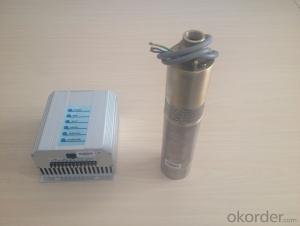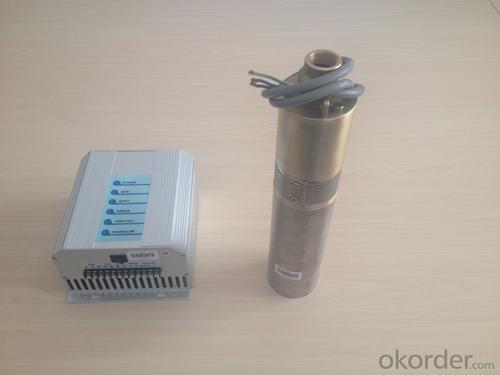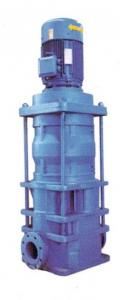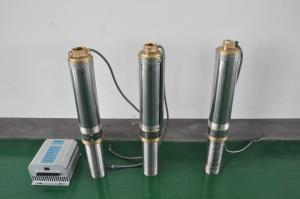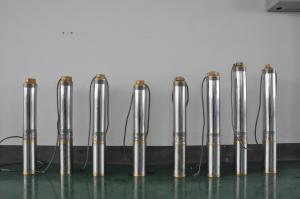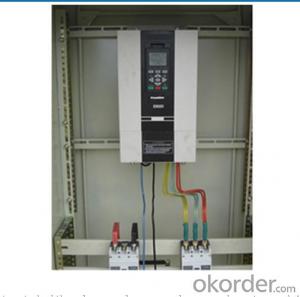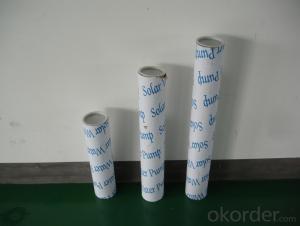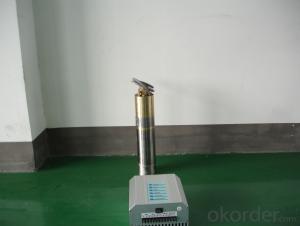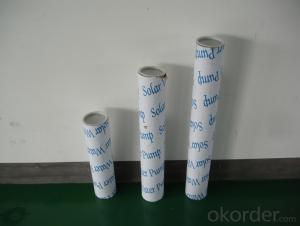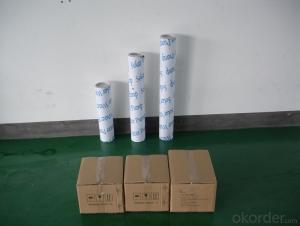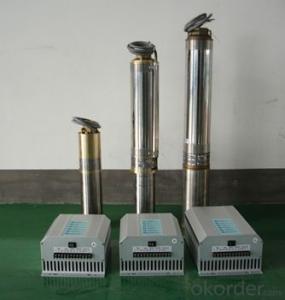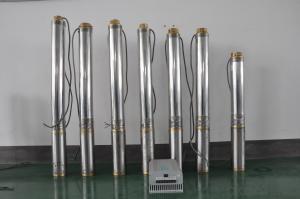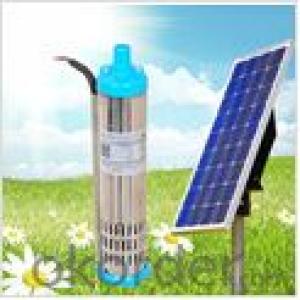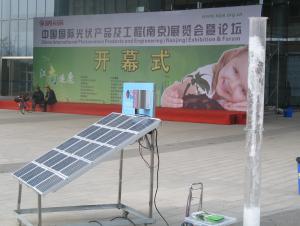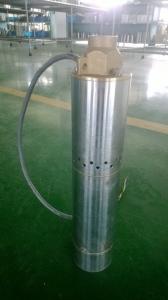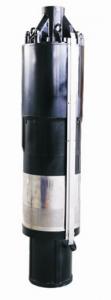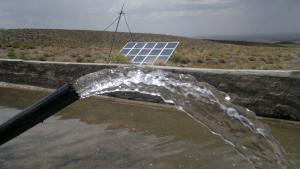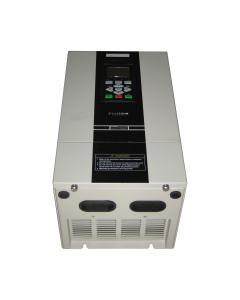Solar Pump Station - DC Solar Submersible Water Pumps
- Loading Port:
- China Main Port
- Payment Terms:
- TT OR LC
- Min Order Qty:
- -
- Supply Capability:
- -
OKorder Service Pledge
OKorder Financial Service
You Might Also Like
Item Description :
This superb new addition to our solar fountain range comes with a 10w solar panel,and a powerful fountain pump that is capable of producing fountains of up to 2m in height. As well as being easy to set up and use.Instruction manual is supplied for assembly and maintenance.
Solar Fountain Key Features :
Powered by direct sunlight
No high voltage electric mains required
Safe for children
Max. height of fountain: 2M
Max. flow capacity: 800 L/H(176 GAL)
10W Polycrystalline solar panel included
18V DC brushless pump
Solar Pump Features :
Can produce fountains up to : 2M (tube height) 1.4M (fountain height)
Comes with multiple nozzle accessories
Cable Length : 5M
Solar Panel Features :
10W peak power.
Polycrystalline highly efficient solar panel
Comes mounted in aluminium frame
Comes with ground stake and rotating knob so you can angle your panel toward the sun
What You Will Get :
10W solar panel
Solar pump
Ground Sake
Nozzle accessories
Precautions :
DO NOT alter or change the product itself or its components
Operate pump in freshwater only, never above 50 degrees celsius
Keep away from flammable liquids
Do not connect to any other power supply other than the included
- Q: What is the maximum pressure that a solar pump can generate?
- Various factors, such as the design and specifications of a solar pump, determine its maximum pressure capacity. Typically, solar pumps can generate pressures between 50 and 100 pounds per square inch (psi), making them suitable for a wide range of agricultural, residential, and small-scale commercial uses. These include irrigation, water supply, and livestock watering. However, it is crucial to consider that different solar pump types and models may have varying pressure limits. Therefore, it is important to consult the manufacturer's specifications or seek professional advice to ascertain the maximum pressure capabilities of a particular solar pump.
- Q: How does a solar pump handle water source contamination from chemical spills?
- A solar pump does not specifically handle water source contamination from chemical spills. However, it can be equipped with additional water treatment systems such as filters or UV disinfection units that help remove or neutralize contaminants in case of chemical spills.
- Q: Can a solar pump be used for water supply in agricultural or farming operations?
- Yes, a solar pump can be used for water supply in agricultural or farming operations. Solar pumps are an environmentally friendly and cost-effective solution for pumping water in remote areas where grid electricity is not available. They can be used for various agricultural activities such as irrigation, livestock watering, and crop spraying, helping farmers reduce their dependence on traditional energy sources and improve overall efficiency. Additionally, solar pumps can harness renewable energy from the sun, making them a sustainable choice for water supply in agricultural or farming operations.
- Q: How does a solar pump handle fluctuations in water quality?
- A solar pump can handle fluctuations in water quality by utilizing various filtration and purification systems. These systems are designed to remove impurities, sediments, and contaminants present in the water, ensuring a consistent water supply and protecting the pump from potential damage. Additionally, the pump's design includes features like self-cleaning mechanisms or built-in sensors that can detect changes in water quality and adjust its operation accordingly.
- Q: How does the efficiency of a solar pump compare to a traditional pump?
- Compared to traditional pumps, solar pumps typically exhibit greater efficiency. By harnessing energy from the sun, a renewable resource, solar pumps operate without relying on fossil fuels or grid electricity. Consequently, they consume less energy and incur reduced operating costs. Advanced technology and meticulous engineering shape solar pumps to optimize energy conversion. Through photovoltaic cells, sunlight is directly transformed into electricity, which fuels the pump. This method eliminates the need for energy transmission, whether mechanical or electrical, thus diminishing energy losses and enhancing overall efficiency. On the contrary, traditional pumps usually depend on grid electricity or fossil fuel-powered engines. These pumps may prove less efficient due to energy losses encountered during the generation, transmission, and conversion processes. Additionally, traditional pumps often necessitate more frequent maintenance and boast higher operational costs, as they rely on external energy sources. Moreover, solar pumps commonly exhibit superior environmental friendliness when compared to traditional pumps. Their operation does not emit greenhouse gases or pollutants, thereby contributing to a cleaner and more sustainable energy solution. Although the efficiency of solar pumps can fluctuate depending on factors like design, size, and application, they generally offer greater efficiency and reduced operating costs in comparison to traditional pumps.
- Q: How does a solar pump help in reducing the risk of crop failure?
- A solar pump helps in reducing the risk of crop failure by providing a reliable and sustainable source of water for irrigation. It allows farmers to efficiently water their crops, even in remote areas with limited access to electricity or unreliable power supply. By harnessing solar energy to power the pump, it eliminates the dependence on expensive and polluting fossil fuels. This not only reduces operational costs for farmers but also minimizes the environmental impact. With consistent access to water, crops can be adequately nourished, leading to improved yields, increased food security, and reduced vulnerability to droughts or water scarcity, ultimately lowering the risk of crop failure.
- Q: Can a solar pump be used for water supply in schools or public buildings?
- Yes, a solar pump can be used for water supply in schools or public buildings. Solar pumps are efficient and sustainable solutions that rely on sunlight to power the pump and extract water from sources such as wells or reservoirs. They are reliable, cost-effective, and environmentally friendly, making them suitable for providing water in various settings, including schools and public buildings.
- Q: How does the elevation of the water source affect the performance of a solar pump?
- The elevation of the water source can significantly affect the performance of a solar pump. The elevation determines the vertical distance that the water needs to be lifted, which directly impacts the amount of energy required by the pump to overcome this elevation. When the water source is located at a higher elevation, the pump needs to work against gravity to lift the water to the desired height. This means that more energy is needed to overcome the additional head pressure, resulting in decreased pump performance. The higher the elevation, the more energy the solar pump needs to generate to lift the water effectively. On the other hand, if the water source is closer to the surface or at a lower elevation, the pump has to exert less energy to lift the water, resulting in improved performance. The pump can work more efficiently, requiring less energy from the solar panels to achieve the desired flow rate. It is important to consider the elevation of the water source when selecting a solar pump system. The pump's capacity and power rating should be suitable for the specific elevation requirements to ensure optimal performance. Additionally, the solar panels' capacity should be determined based on the energy needed to overcome the elevation, ensuring that sufficient power is available to run the pump effectively. In summary, the elevation of the water source directly affects the performance of a solar pump. Higher elevations require more energy and can decrease pump performance, while lower elevations allow for improved efficiency and better pump performance. Proper consideration of the water source's elevation is crucial in designing and selecting a solar pump system.
- Q: How does the efficiency of a solar pump system vary with different pipe sizes?
- The efficiency of a solar pump system can vary depending on the size of the pipes used. The flow rate and pressure of the system are directly influenced by the size of the pipes. In general, when larger pipes are used, the flow rates can be increased and the pressure losses can be reduced. This results in higher efficiency because larger pipes have less friction, allowing the water to flow more easily. Consequently, the pump does not have to exert as much effort to move the water through the system, which leads to improved energy efficiency. On the contrary, if smaller pipes are used, there can be increased pressure losses and reduced flow rates. This can adversely affect the efficiency of the solar pump system. Smaller pipes have more friction, causing the pump to work harder in order to maintain the desired flow rate. This can result in higher energy consumption and reduced efficiency. It is important to consider that the optimal pipe size for a solar pump system depends on various factors, such as the desired flow rate, distance, elevation changes, and the capabilities of the specific pump being used. Seeking advice from a professional or conducting hydraulic calculations can help determine the ideal pipe size for a given system, ensuring maximum efficiency.
- Q: Can solar pumps be used for water supply in community centers or social projects?
- Yes, solar pumps can definitely be used for water supply in community centers or social projects. Solar pumps are a sustainable and cost-effective solution that can provide reliable water supply without relying on electricity grids or fuel. They can be easily installed in remote areas and can efficiently cater to the water needs of the community center or social project. Additionally, solar pumps are environmentally friendly as they utilize clean energy from the sun, reducing carbon emissions and promoting sustainability.
Send your message to us
Solar Pump Station - DC Solar Submersible Water Pumps
- Loading Port:
- China Main Port
- Payment Terms:
- TT OR LC
- Min Order Qty:
- -
- Supply Capability:
- -
OKorder Service Pledge
OKorder Financial Service
Similar products
Hot products
Hot Searches
Related keywords
